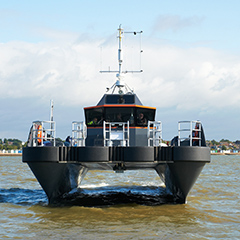Hybrid electric SWATH design advances following feasibility study
Brightlingsea, 10th December 2013 – A feasibility study around a hybrid powertrain SWATH, commissioned this year by CTruk, has given the company further impetus in its ongoing development of a hybrid electric offshore wind support vessel design.
The study was based on the CTruk CWhisper SWATH, a 20m craft fitted with twin Cummins QSM-11 marine diesel engines and Rolls-Royce Kamewa FF41 waterjets. The feasibility report concluded that the implementation of a parallel hybrid solution would result in substantial operational cost savings on this particular vessel, an attractive prospect coupled with the already well-documented advantages of the SWATH hull form in offshore wind operations.
Marine craft in the offshore wind support sector typically have two major transit periods each day, with the rest of their time at sea spent idling or slow manoeuvring with the occasional high speed peak. This usage profile makes OWSVs ideally suited to a hybrid configuration. The introduction of an electric motor to handle the load during low power demand periods allows the boat’s engines to be turned off or run as generators at a more optimised power rating. As well as the obvious fuel savings incurred, this reduces hours and wear on the engines, a key point for commercial marine vessels which typically require engine services every few weeks. The life expectancy of an engine could be increased dramatically if the craft ran electric during idling downtime, as these craft can idle for up to 50% of a shift offshore. Resulting reduced maintenance and direct costs also represent significant savings.
CTruk builds high-speed vessels using resin-infused FRP composite, a robust material that is around 40% lighter than aluminium. These vessels are therefore well able to take the extra weight of the additional drive train needed for hybrid operation, a small price to pay for the resulting greatly reduced running costs possible over the vessel’s lifetime. The unique belt drive transmission system currently being fitted on CTruk’s latest SWATH build will be included on all subsequent CTruk SWATH vessels, future-proofing these craft by allowing for the retrofitting of a parallel hybrid solution.
Jim Cutts, director of engineering at CTruk commented, “CTruk has always strived to offer more cost- efficient workboats and the reduced fuel consumption of our lighter, composite vessels has been a key factor in achieving this aim. We envisage that the significant further reduction of fuel usage on a hybrid electric vessel will see CTruk’s product range thrust forward into the future of offshore wind construction and O&M, a future where efficiency and cost reduction reign.”



























